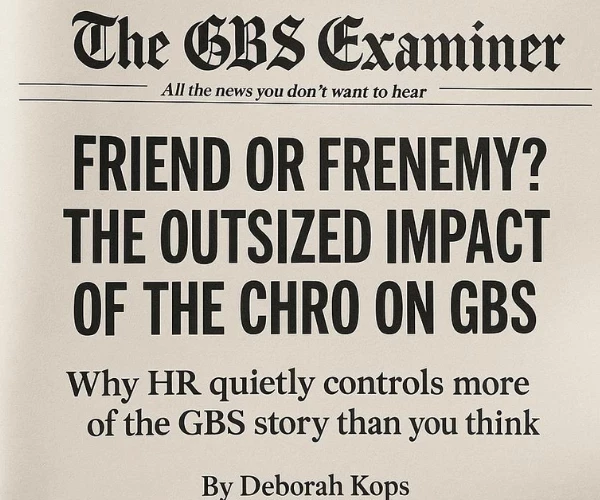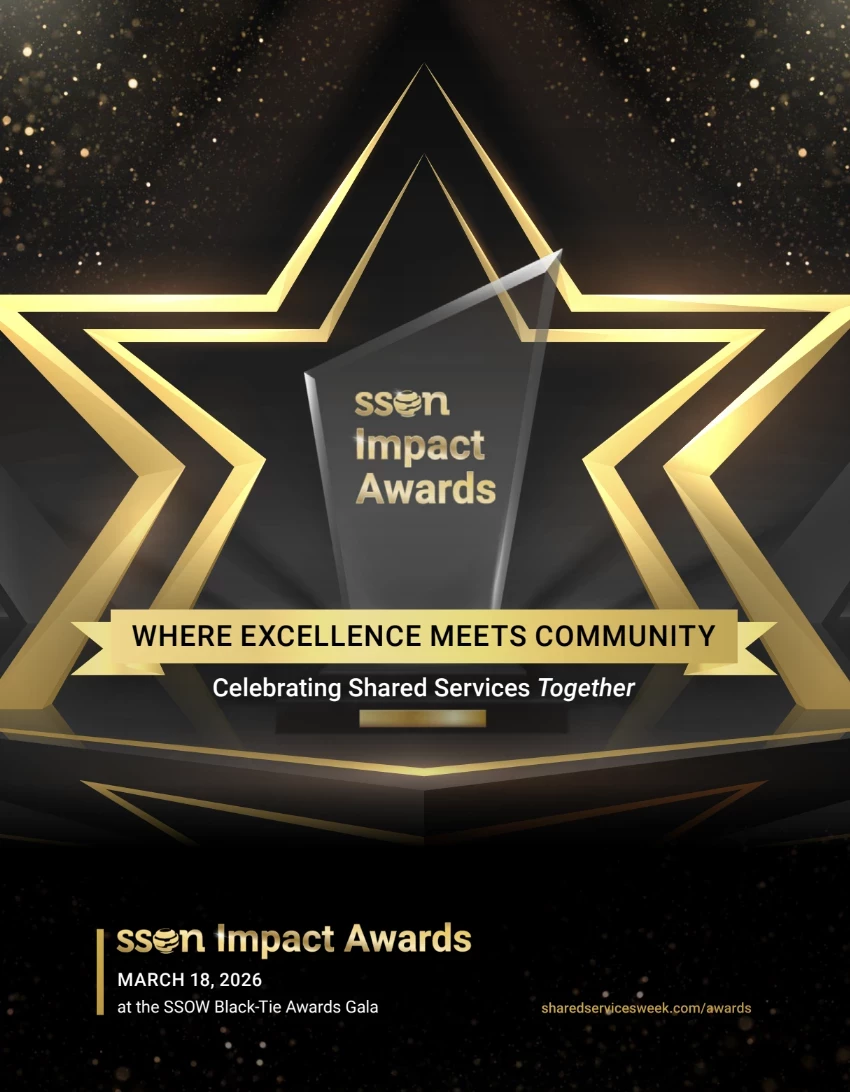Creating a Brand New Strategy for Shared Services: P&G's Global Business Services
Add bookmarkAs Procter & Gamble continued to demand more from its shared services organization, it was clear that business as usual wouldn’t work. Something needed to be done in order to take the organization to the next level — but what?
When you work for the company that literally invented brand management you get back to basics and do what you do best: build a brand! On September 20th, 2005, the Global Business Services (GBS) brand was formally established at P&G. This decision was not just about creating a logo and some new letterhead. It was about taking an innovative approach to run shared services like one of P&G’s billion-dollar brands. This meant extending a foundational P&G principle—"The Consumer is Boss!"—to the farthest reaches of the back office.
To someone outside of P&G, "The Consumer is Boss!" might sound like a whimsical slogan. Yet, these four simple words are the driving force behind a company of over 130,000 employees focused on transforming consumer wants and needs into brands that excite, delight and deliver. It represents a deliberate approach to innovation, focused on matching what’s needed with what’s possible. Extending this approach into shared services has created a whole new "value-creation" mindset at P&G. When we looked at the core project activities of our services we noted that they typically fell into one of the following categories:
- Creating NEW offerings that address unfilled needs;
- IMPROVING offerings so they provide more benefits;
- EXPANDING offerings to new areas of the business;
- Making OPERATIONAL changes that reduce cost while improving quality.
Think of these categories as the four cylinders in a car engine: For maximum performance they all need to work in harmony. While we were very strong at expansion and operational efforts, we recognized that new and improved innovation of our service offerings represented untapped opportunities. To take the car analogy farther: we were getting great gas mileage but we weren’t going as far as we wanted to go.
The key learning here was that the value potential from operational cost reductions is limited. If you have a million-dollar operation, the maximum cost savings are restricted—at a million dollars. But value generated from innovating new or improved offerings is only limited by the power of the idea! To deliver substantial value over the long term, we knew that a solid service strategy was needed to innovate beyond operational cost savings.
Here’s the catch: creating new and improved services is hard work! To do it right requires a new set of processes and capabilities that are foreign to many shared services organizations. These are marketing, research, and innovation. Recognizing the need to develop these new processes and capabilities, GBS leadership took deliberate action: they brought in cross-functional transfers from P&G’s brand management and consumer research organizations. They also sent their leaders on broadening assignments. Together, these individuals formed a team to accelerate the development and incorporation of these new processes and capabilities into the organization.
With a dedicated team in place, the GBS brand came to life very quickly. The brand’s logo, color scheme, and overarching design elements were incorporated into documents, presentations, and physical workspaces. As new initiatives were launched, communications such as posters, websites, and e-mails took on a consistent look and feel. These were visible cues that highlighted the fact that GBS was no longer a conglomerate of different organizations hidden away in the back-office. It was officially a brand.
However, the real transformation did not occur because of a logo. It’s what the logo stands for that is most important. GBS symbolizes a promise to empower clients to achieve their business goals and to put users at the heart of every effort. This fundamental promise drives everything and everyone. Innovation, portfolio planning, projects, daily operations, rewards, recognition, communications, etc… all reinforce execution against the promise.
Now GBS delivers over 85 services in more than 80 different countries around the world and the results of the transformation have been breakthrough:
- customer satisfaction scores improved year-over-year to a record 8.9 out of 10;
- cumulative savings of $600 million dollars were delivered; and
- average user-satisfaction scores have increased across all services.
People are energized. Work has extended beyond managing operations and cost centers. Instead of being "order-takers," people are truly managing a brand. Leadership recognition has grown. Today, GBS is one of the four pillars of P&G’s organization and has been recognized by AG Lafley, Procter & Gamble’s CEO, as "indispensable to our ability to win the consumer-value equation day in and day out—and deliver long-term sustainable growth year-in and year-out."
Pursuing a journey to transform shared services into a brand isn’t easy—and it never ends. Once you commit, it’s like letting the genie out of the bottle. You can never go back to doing business like you did before. But the benefits can be significant, because instead of reacting and cost cutting, you can be proactive and innovate new sources of value.
If this sounds worth pursuing here are seven considerations to help you succeed:
(1) Commit To The Change
From day one, ensure that shared services’ leadership is aligned. Establish an overall vision and charter that outlines the approach, value potential, and key measures of success. Include both in-process measures and outcome measures. Involve organizational leaders in developing the vision and have them commit by physically signing the charter. Maintain visibility by reviewing progress regularly.
(2) Organize For Success
Designate a single person to lead the effort. They should report directly to the executive in charge of the shared services business. This will emphasize the importance of the effort and ensure barriers are quickly removed along the journey. Also, grow leaders who will thrive in the new environment, investing in new tools and capabilities. Bring in talent from other functions associated with marketing, research, and innovation to act as guides and change agents throughout the journey.
(3) Define The Brand
Don’t fool yourself into thinking that all you need to do is create a pretty logo. Defining a brand is about clearly establishing a promise and the underlying service structure and brand architecture to deliver, expand, and communicate that promise. A marketing expert can help you manage this process.
(4) Empower Service Owners To Be Brand Managers
Brand management is different because it means that a single individual is responsible for an end-to-end service. Thus, the owner of a payroll service may not actually own the day-to-day operation and underlying systems that deliver parts of the service, but they direct how and where the resources are used to deliver that service. These owners are held accountable for key performance indicators such as cost, satisfaction, adoption, and value creation from the service. This goes beyond governance to include leading the service strategy and associated project portfolio, making decisions about the service, and allocating money and people as required. It also includes pricing and recovery of the funds necessary to deliver the service. Doing this effectively requires the organization to have a clear definition of the services—not the systems and tools that are offered to the business.
(5) Manage Projects As Commercial Initiatives
Categorize projects based on the four categories outlined previously (new, improve, expand, operational). For efforts related to new and improved offerings, take a brand manager’s approach. Create service concepts, mock-ups, prototypes, and pilots. Set very clear success criteria against each activity. Research each step with clients and users to ensure it meets their needs. That way, resources can be allocated to the biggest, most innovative ideas—and bad ones can be stopped early in the process.
(6) Invest in Research & Innovation
Innovation is the lifeblood of any service. Invest in exploring what’s possible and create a culture where it’s OK to fail early. Here are a few things to consider:
- Go beyond surveys and encourage people at all levels of the organization to personally conduct research by meeting with customers. Everyone should be expected to be "in touch."
- Set up a process for service leaders to submit new and improved service ideas. This can be done ongoing, quarterly, biannually, etc… and should link directly to the processes and people who can develop those ideas into actual services.
- Consider creating an innovation and research team to coordinate activities across the entire business. They can help accelerate this important work
(7) Create A Brand Management Culture
Culture is the secret ingredient that separates winners from has-beens. Creating a brand culture demands that everyone in the organization think about their work in a completely new way. Here are some examples of how thinking might change.
| OLD | NEW |
| Inside out (organization first) | Outside in (clients & user first) |
| What the technical specs are | What users need |
| On time, in scope | Satisfaction and actualized value |
| My manager's opinion | Data from client & user research |
| Organization budget | Service profit and loss |
| Responding to requests | Showing what's possible |
| System availability | Adoption & usage frequency |
The important takeaway is that the culture has to change. Define what the right culture should be for your brand and then work with HR to ensure the appropriate rewards and recognition processes are in place to
reinforce it.
In summary, transforming shared services into a brand is about positioning yourself to deliver long-term value. While it may be a "Brand New" idea for shared services, the fundamentals are based on battle-tested brand management practices that have been refined for almost a century. If done right, it has the power to take your organization from ordinary to visionary… and also to take you from the back seat to the boardroom!
––––––––––––––––––––––––––––
In preparation for taking on a commercialization role within GBS, and as part of the leadership’s cross-functional transfer strategy, Jon Hanley was seconded to P&G’s IAMS division for six months, to learn about branding from one of the company’s leading products.
Q: WHICH BRAND DID YOU WORK ON?
A: Three and a half years ago, I spent an intensive six months working on the IAMS brand based in Dayton, Ohio. Because I managed our shared services business within the North American IAMS plants, I was familiar with the products and was able to get up to speed very quickly.
Q: WHAT WAS IT LIKE MOVING INTO MARKETING?
A: There was a steep learning curve. I distinctly remember my first week on the job when I was asked to review and approve package designs before they were sent to print. Having never done that, I stayed late reviewing the designs to ensure that nothing was missed. After countless hours, I found a minor punctuation error and was satisfied. Several months later I saw the new packaging in the store. I realized that being in marketing takes you as close to the business as you can possibly get.
Q: WHAT IS THE BIGGEST IDEA SHARED SERVICES CAN REAPPLY FROM BRAND MANAGEMENT?
A: When you mention brand management, most people immediately think about advertising. Advertising is powerful, but the biggest opportunity for reapplication is the brand management model itself. It is very effective because:
- It’s always clear who makes the decisions. This minimizes work that doesn’t support the strategy.
- Decisions are based on a combination of financial analysis, and consumer and market research. Because of this, people know what's important and how success is measured.
- Multifunctional teams can quickly be formed to tackle a problem. The best people from market research, R&D, operations, finance, advertising, sales, etc… can be called in at a moment’s notice. They can make good things happen very quickly and ensure sore spots get taken care of before they turn into big problems.
- Most importantly: The process to bring new products to market is clear and everyone knows their role. Because the process is directly linked to decision making and data-based research, good ideas get accelerated and the bad ideas get stopped. This improves ROIs and overall value generated for shareholders.
Q: OK, SO WHAT ABOUT ADVERTISING? ARE THERE ANY LEARNINGS THAT CAN BE REAPPLIED TO SHARED SERVICES?
A: When it comes to advertising I focus on the fundamentals. There are three things to always keep in mind:
- Have a clear objective. Ensure you know WHY you need to advertise and how success will be measured.
- Create a plan. Good communications requires a relevant message for each individual audience and messages should be reinforced several times. The planning process will ensure that nothing is missed.
- Deliver a flawless execution. Execution is what people actually experience. Misspelled words, poor timing, ineffective visuals, etc… can translate into failure. Don’t cut corners here. Invest the time, money, and people to do it right. That way you will achieve your objective.
Remember that even the best advertising won’t compensate for a bad product or service. If service delivery is bad, investing more in advertising will just increase awareness of your bad service, thus creating more headaches for you to deal with.
Q: DID YOU NOTICE ANY CULTURAL DIFFERENCES IN MARKETING?
A: Marketing is a "written" culture. Coming from an IT background, I was accustomed to PowerPoints, process flow diagrams, and technical documentation. That’s not how marketing operates. Every request, idea, recommendation, or status report centers on written one-page documents. The mantra is "If it’s not written, it’s not real!"
This approach forces clarity in thinking and exposes bad ideas very quickly. Describing something in two written paragraphs instead of 20 PowerPoint slides requires you to truly understand the subject in detail. While data, charts, and graphs are always required as reference, the centerpiece of every proposal, request, or update is a written document. A common saying that embodies this approach is "less is more."
Q: OVERALL, WHAT DID YOU FIND MOST VALUABLE ABOUT YOUR EXPERIENCE?
A: The ability to go "native" and truly be a user of shared services was illuminating. During my assignment I didn’t have to think about SLAs, outsourcing, system upgrades, or what next year’s project portfolio was going to be. I was free to disconnect from my previous work and fully dedicate myself to marketing. This allowed me, truly, to see our shared services from the client and user point of view. I pull upon this knowledge daily when helping people develop strategies for their services.
Q: ARE THERE ANY OTHER KEY TAKEAWAYS FROM YOUR EXPERIENCE?
A: Demand that your people conduct research with clients and users regularly. One of the most valuable experiences I had was conducting research with cat owners. About two minutes into a research session I realized I knew absolutely nothing about cats or the needs of cat owners. I knew it would be impossible for me to develop products for them if I was out of touch with their needs. This experience was transformative. Consumer is Boss took on real meaning! This inspired a desire to be the best researcher I can be and a passion to help others do the same. Research is something that everyone can and should do. It just requires discipline, dedication, and a culture that rewards it.
Q: DO YOU HAVE ANY SUGGESTIONS FOR OTHER SHARED SERVICES ORGANIZATIONS THAT WANT TO ARRANGE BROADENING ASSIGNMENTS?
A: I highly recommend sending people on broadening assignments. Not only is it a visible and effective way to develop top talent, but the experience, knowledge, and fresh perspectives gained will help build the business. It helps to think of broadening assignments as extended research, where the employee is an anthropologist. Besides developing a new set of skills and contributing during the assignment, their job is to generate deep and meaningful insights into client and user needs.
Here are a few things to keep in mind when structuring the assignment:
- Choose the right people. Having mature, open-minded, and highly experienced candidates will ensure that you both get the most out of the assignment. It will also reduce the risk of poor performance in the role.
- Work with the business to develop a workplan that provides the candidate with challenging work and a variety of different experiences.
- Periodically review their progress, learnings, and adjust as necessary.
- Define a role to transition back into that will allow them to immediately share and reapply their knowledge. You won’t realize the benefits of the assignment until they come back to your organization.
- Ask them to document what they learn. Be prepared to coach them on different ways to translate those learnings into action.
----------------------
About the Author
Jon Hanley is the marketing strategy leader in P&G’s Global Business Services unit, where he leads efforts to bring brand management to life within the organization. His work focuses on strategic consulting for shared services and their related initiatives, delivery of training, and development of best practices.
Mr. Hanley’s 10-year P&G career started in IT with a focus on ERP systems and later expanded to leadership of shared services operations within various P&G production facilities. After finishing his MBA, he completed a broadening assignment in marketing working on the IAMS brand. While originally from the United States his work includes two expatriate assignments in Mexico and Puerto Rico.





























